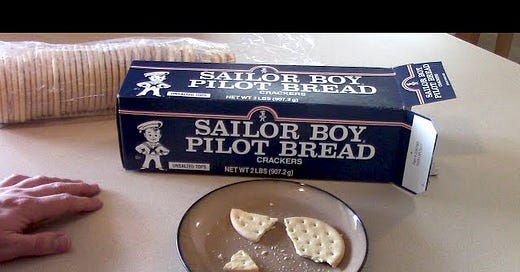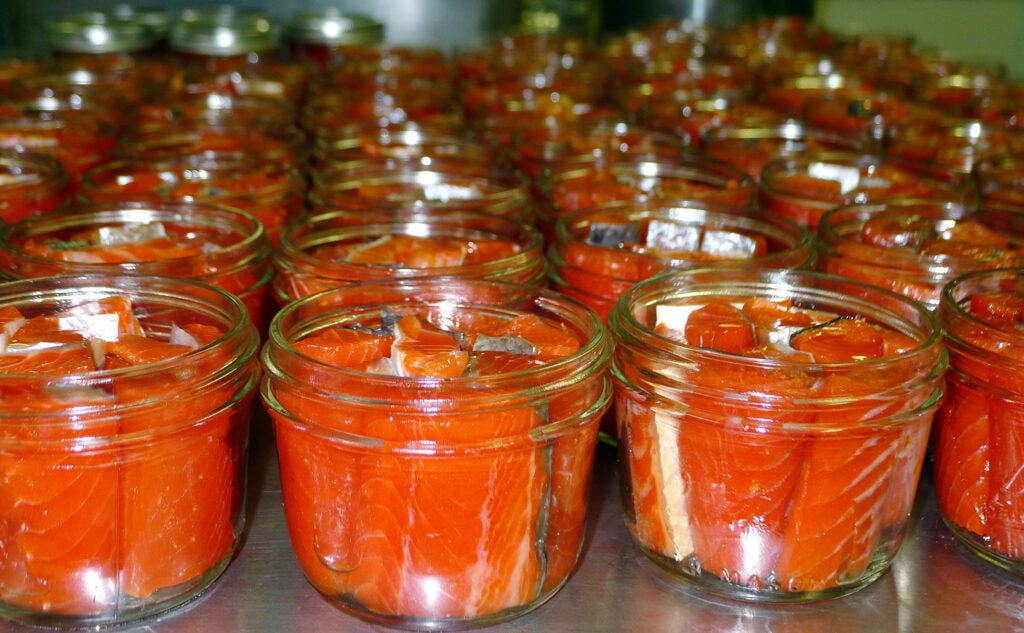I was talking to a friend from Florida about their vibrant Cuban food scene when she paused and asked me, “What’s Alaskan cuisine like?”
“Cuisine?” I said with a chuckle. I had never thought of Interior Alaskan food as a cuisine as that sounds especially dignified compared to what I remember growing up, which in my household included a lot of ninety-nine cent chuck steaks from the Safeway as well as frequent trips to the Wendy’s, and any Alaskan will swear to you that Wendy’s makes a better burger than any trendy spot on the Food Channel, a result of it at one time being “all we had.”
Yet as I jogged my memory, I realized most everyone I knew growing up in the North Star Borough had the same staples in their pantries and spare horizontal chest freezers in their garages.
The common tie is that these items can survive a hard winter and can be called upon at any time.
Pilot Bread is a form of hard tack. If you don’t read a lot of books about ancient seafaring, this is a dense cracker with the highest shelf life of any food on earth.
Sailor Boy brand Pilot Bread is the only acceptable form and is ubiquitous. The manufacturer lists its shelf life as thirty years, yet it’s quite possibly immortal like a box of Q-tips.
The flavor is tellingly dry, and if one were feeding their children plain Pilot Bread a visit from social services would be in order. However, top it with cream cheese or peanut butter and you have yourself a copacetic snack ringing in at around five cents which you can enjoy in front of the TV or from your burned-out bush plane as you are stranded on the barren tundra never to be seen again.
I’m certain every native Alaskan can recall at least one childhood instance of bitching about not having any food in the house, and an overworked mother shouting, “Get yourself a piece of friggin’ Pilot Bread!”
Ideally, or if it were a special occasion, you’d want to reach into your cupboard for a jar with the word “Kerr” sculpted onto the side and pull out a jar of smoked salmon.
Canning is widespread in Alaska in the summer months blueberries and raspberries are plentiful and can be made into a quick and delicious jam to store through the winter, and why is this sounding like I grew up in Little House on the Prairie times?
Salmon is the caviar of canned goods.
When I left Alaska, I sometimes encountered smoked salmon in the form of lox, which I found slimy and mealy and pale and seemingly boiled, an abuse of the term ‘smoked salmon.’
When you go fishing in Interior Alaska, you’re going to catch your limit of salmon if you have any idea what you’re doing, at least a few coolers full.
Any responsible Alaskan will dedicate some portion of this salmon to smoking, which usually involves stringing the filets up above a burning fire, giving them a nice char and enhancing the deep redness of the flesh.
Depending on the type of salmon it’s probably excessively oily, which is a good thing, as it’s high oil content can permeate the pilot bread and prevent you from chipping a tooth.
Now you’ve got yourself a proper balance of texture and flavor, a dish better than anything you’ll find in a fancy restaurant in the states.
Most Alaskans have a nuclear holocaust worthy supply of meat on hand at any given time, which is why a spare garage freezer is often needed.
In this freezer you will find some salmon filets, of course, and usually moose also.
Moose are the most commonly hunted game in Interior Alaska, and they are enormous. A bull can weigh up to fifteen hundred pounds, but a thousand pounder is common. An investment of a few days of hunting can basically feed a family for an entire winter.
Many of my Native Alaskan friends would disagree, but moose meat has the gamey flavor of a gladiator cow, with a slight fast twitch aftertaste. It’s commonly made into burger patties or stew, either of which will lead your house to smell like mastodon hunt, yet moose stew is a celebratory dish and you should probably get a bowl of it to be polite or if you just competed in an Olympic powerlifting competition and need to regenerate.
My family were one of the few who didn’t store wild game, as my parents were not Alaskan and retained more of a modern American reliance on the grocery store, where the meat would be shipped, what, three thousand miles and arrive in a freezer-burned block.
“You want to eat moose? Gross,” my mom would say, and so we refrained from anything freshly harvested from the land and instead supported factoring farming and braved mad cow disease.
Reindeer sausage was usually on hand. Reindeer and caribou are the same animal, and I suspect the dry Alaskan sense of humor led to referring to it as the former, as the thought of eating Rudolph likely initially horrified outsiders.
Elk was also a staple, a boring foodstuff, the turkey sandwich of the far North.
Also common were black bear, grizzly bear, Daal sheep, even Muskox, smaller cuts of meat wrapped in little cocaine brick style packages which held sentimental value to the man of the house and provided the peace of mind that the memories of his kill would still be there, year after year, decade after decade.
Regardless of the amount of hair on your chest, nobody wants to eat moose on a nightly basis, and so in the freezer in one’s kitchen would usually be an assortment of Bird’s Eye pot pies, which were often on sale at ten-for-a-dollar and I believe have since been discontinued. Eggos and El Monterey half-racks of frozen burritos and other common nonperishable foods were a lifesaver.
In the summer fresh food was easy to harvest or cultivate. It wasn’t just raspberries and blueberries, which were plentiful enough to fill a cut-off milk jug within a matter of ten minutes.
Rhubarb, which is a sweet celery and a stupid word, would spring up when the snow melted. A blueberry pie is something to be coveted, but don’t sleep on a rhubarb pie, with its sweet and slightly bitter flavor profile, it’s the thinking man’s pie.
And anything that would grow in Ireland will grow in Alaska in the summer, potatoes, carrots, turnips, cabbage, and to an impressive degree, as Alaskan cabbages are the biggest in the world, by far.
It wasn’t a lot of information to give to my friend, but I realized that Alaska does indeed have a cuisine. It’s rustic without frills, much like the Interior itself, but to be fair I have never once missed the Pilot Bread.






